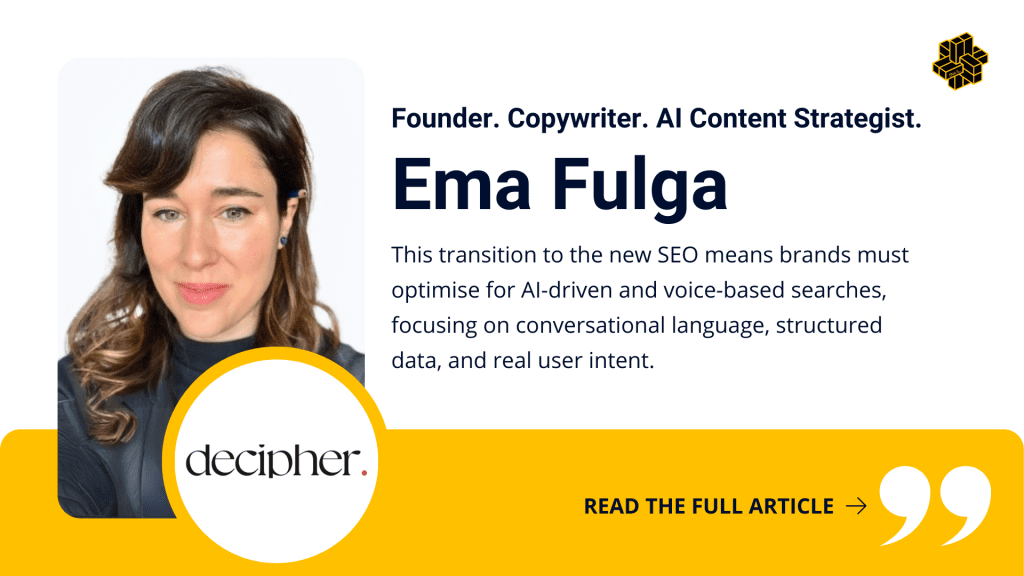
SEO 4.0: Optimising for Audio and AI-Powered Searches
For those who believe SEO is a science, I’m here to challenge that concept and say that given its evolution, I’d argue it’s more a sort of art form than an exact science. As AI-powered search engines and platforms such as Perplexity, Gemini, and ChatGPT are redefining how users find and consume information, we see ourselves entering a new era of SEO: optimising for conversational audio searches and AI-driven tools.
In just a few years, we went from typing well-thought-out queries like “best smartphones” to asking full, intent-driven questions, often via voice assistants. This type of search had already gained traction a while back due to Google’s voice feature since using voice commands feels more intuitive. However, the real tipping point came with the rise of conversational AI tools like ChatGPT, which made it second nature to search for something like “Where can I get an authentic carbonara near Soho at 8 PM?” instead of typing “best Italian restaurant in London”.
This transition to the new SEO means brands must optimise for AI-driven and voice-based searches, focusing on conversational language, structured data, and real user intent.
Let’s dive into the key changes shaping search and the practical strategies brands can implement to ensure their content is AI-ready.
From traditional SEO to SEO 4.0
Old vs. new: What’s changed in SEO?
With Google having dictated how websites are ranked and which content is relevant for decades, it’s no wonder that SEO practices have been a core focus for businesses. It all started with basic keyword optimisation and the number of backlinks; the more, the better, and the quality wasn’t a factor at first. This made search results easy to manipulate, so Google introduced PageRank back in 1998, a system that prioritised link authority and penalised keyword stuffing.
This marked the beginning of the content marketing era, when blogging was more popular than a Cola on a hot summer day. Everybody knew a travel blog or a beauty blog at that point, and no niches were too small.
Then, in 2015, Google announced several major updates: prioritising mobile-friendly sites, processing natural language more effectively, and voice search optimisation with question-based content.
Then, something completely unexpected happened in 2022. Between November and December of 2022, two new AI-powered tools would push user expectations regarding how to search for information to new highs: ChatGPT and Perplexity.
For the first time, Google’s reign was put into question. Why? Mainly because tools like Perplexity don’t just list links; they pull information out of millions, if not billions, of sources and answer questions directly. Gone are the days when users had to navigate 10 tabs in order to have their questions answered.
So, what does this mean for brands?
How AI and audio search are changing digital marketing
First of all, if you’re not a major brand with countless pieces of content and mentions on billions of websites, you’ll notice your click-through rates go down a bit. That’s because AI searches extract the information and summarise it so that consumers can “consume” it directly inside the tool where the search was made. Also, if they require more information, they’ll most likely ask the tool to do it for them instead of clicking the sources and going through the website searching for answers, which usually takes a lot longer to do. So, users will rarely feel the need to leave the AI-driven tool and go to the source.
Second of all, if a website isn’t optimised for AI-powered tools, its content won’t be seen. Many of the SEO principles stand since most of the information is taken from websites through search engines like Google but further, more precise, optimising is necessary. Structured data is more important than ever. AI tools won’t even register the content without it.
Last but not least, AI-driven tools and search engines read and process conversational content easier and they “understand” voice-friendly UX better since they’re built for natural, human-like conversations. This ties in nicely with the transition to voice searches we’re seeing.
The rise of conversational search
Voice search isn’t new. Google introduced this feature back in 2008 as an experimental feature for mobile devices, and it only worked on iPhones. Later, in 2010, it expanded to Android devices, and it was only integrated into Google Chrome as a desktop feature in 2011.
Today, this feature is key for voice and AI assistants alike. The shift is in how we search for information and the capabilities these tools have because, while Google’s voice search feature has been available for a while now, it was only used as an extension of the traditional search practices of the time. People searched for “top places to visit in Vietnam”, whether it was manually or by voice, and that was fine because Google’s capabilities weren’t prepared for more conversational searches like “What are the top places I should visit in Vietnam during a 5-day trip in April?”. Unless someone had this exact question in a header on a website somewhere, you’d get the same long list of links talking about Vietnam.
Nowadays, AI and voice assistants handle full-sentence, intent-driven queries. In a span of a few years, their capabilities went from simple, direct queries to complex commands that contain several variables. In the past, you had to be very intentional about how you asked for information. If the query was too long, too detailed, or didn’t speak directly to the task at hand, you’d get bad results. Nowadays, you don’t have to think about it at all. You can give as much context and background to ChatGPT as you want and, in fact, it’s better if you do because it will feed back more precise results. Searching went from “How to cook a lasagna?” to “How can I cook a lasagna that’s typical from Sicily if I only have these ingredients in my fridge… ?” in just a few years.
Given all this level of detail that many people give AI-powered tools when they search for something, what does it look like from the brands’ perspective? How can a company optimise its content for AI searches?
So, what do AI-powered search engines and platforms prioritise?
First of all, AI prioritises content that aligns with user intent and conversational language because it improves engagement and comprehension. The reason is that its job is to crawl websites, digest their content, extract insights across multiple sources, and feed back the information, in just a few seconds.
A common misconception is that it favours natural, human-like language because it mirrors the style in its answers, but that’s not true. AI-generated responses are influenced by the tone and structure of the sources they pull from but are not necessarily designed to match an individual user’s tone directly.
This elaborate process is quicker if the website has featured snippets and structured data. Schema markup (also known as structured data) helps AI and search engines understand content faster, which improves the chances of it being featured in its answers. Featured snippets are easily digestible pieces of content like the ones in FAQs, lists, or bullet points. They increase a site’s visibility because it allows AI to extract clear, direct answers to queries.
Last but not least, AI-powered search doesn’t just look for exact word-matching, it understands context and meaning. So, instead of focusing on specific keywords, it knows how to connect related ideas, synonyms, and user intent. For example, in the old days, you’d Google something like “best budget hotels in Paris”. But now, you can go to Perplexity and search for something like “I’m travelling to Paris on a budget. Which hotels offer good value near the city centre?”
How can a brand optimise its content for AI-driven intent?
Strategies for optimising for AI & voice search
Focus on conversational and question-based content
With exact-match keywords taking a backseat to clear, intent-based content that answers questions, strategists need to stop treating content like a keyword checklist and start thinking about how people naturally ask questions. AI feeds back insights from content that directly answers questions, so incorporate FAQs, how-to guides, and structured Q&A formats. And any type of content that’s easy to digest and answers a clear question.
Target long-tail and intent-based keywords
Move beyond short, generic keywords and optimise for question-based, intent-driven phrases. Tools like AnswerThePublic, Google’s People Also Ask, and Perplexity AI queries can help discover long-tail keywords that might not come to mind otherwise.
For example, instead of optimising for keywords like “best running shoes,” target “What are the best running shoes for people with flat feet?” as it aligns better with how AI pulls content out and prioritises it for its answers.
Implement structured data and schema markup
This is where it gets a bit more technical, but you don’t have to be a developer to implement structured data. ChatGPT and other similar AI tools can generate schema markup, which you’ll then have to add in the backend.
Since AI relies on metadata and schema markup to pull information, this step mustn’t be skipped.
For example, a recipe blog should have structured markup for Ingredients, Cooking time, and Step-by-step instructions. This helps AI understand your content faster and serve it in rich snippets, voice search results, and AI-generated responses.
Optimise for voices search-friendly UX
With voice search becoming more and more popular, AI-driven assistants are designed to prioritise fast, clear, and accessible content. This places spoken queries, not just types ones, at the core of today’s UX.
Voice search thrives on instant answers. Google prioritises pages that load fast, so if your site is slow, you’re already losing. Optimising images, compressing files, and minimising unnecessary scripts that slow things down increase loading time substantially. Tools like Google PageSpeed Insights are great for checking and improving load times.
As most voice searches happen on mobile devices, content needs to be designed and built for small screens first, and desktops second. As a rule, responsiveness is more important than ever. The texts also need to be scannable, so it is best to use short sentences, clear headings, and bullet points. Also, make sure clickable elements like buttons aren’t too small, but finger-friendly.
Since voice search users prefer listening over reading, integrating audio content can boost engagement and visibility. Adding short-form audio snippets makes it possible for users to listen to key sections instead of reading. Including podcasts or voice summaries at the start of blog posts provides quick takeaways, making content more digestible. Additionally, incorporating text-to-speech features gives users the option to hear the content rather than scrolling.
By optimising for speed, mobile usability, and audio content, you’re making your site AI-friendly and voice-search ready. This means better rankings, higher engagement, and more visibility in AI-powered results.
The future of SEO
As search engines evolve, so do user behaviours and the main difference it’s driving is that SEO is moving away from prioritising ranking above all else, towards the idea of being relevant in an AI-driven world. With AI tools delivering instant, intent-driven answers, traditional search strategies are losing ground. More zero-click searches mean fewer users visiting websites, making structured, scannable, and voice-friendly content essential to staying visible.
Brands that fail to adapt risk falling into a search engine limbo, while those that embrace AI-first strategies will dominate the market. So, run an audit and start optimising for AI-powered search.
A big thank you to Ema Fulga, founder of Decipher, for sharing this insightful article on the evolution of SEO. As AI-powered search transforms how users find information, Ema breaks down the key strategies brands need to stay ahead.
About Ema Fulga
Ema Fulga is a freelance copywriter and founder of decipher., a UK-based creative agency specializing in personality-driven content. With over eight years of experience, she has worked with brands like Publicis, NTT DATA, and SMEs across Europe. Ema’s expertise lies in crafting unique tones of voice and optimizing content for AI-powered search. Beyond decipher., she is publishing her first children’s book, completing a historical novel, and co-owning a beauty distribution business.
Join Us Now!
See more MarTech Thoughts Content/ Interview pieces here!
Stay up to date with our In Person Summit, Session Information, and Agenda Updates by following us on:
Last updated: February 2025













